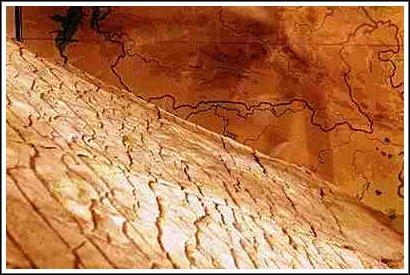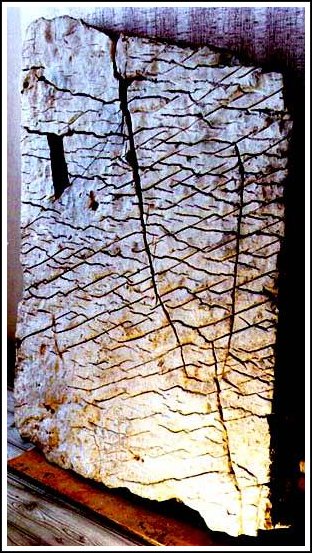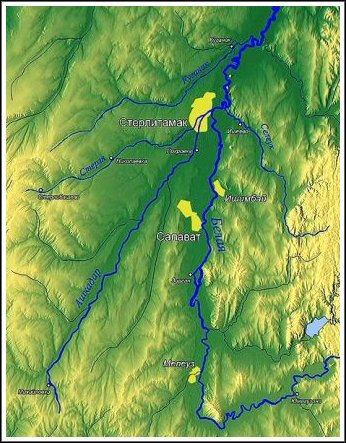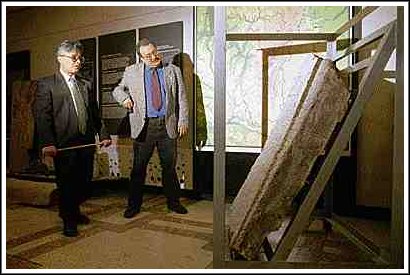Map of the Creator


In 1999, Vladimir Krainov had a massive rock in his yard which was being used as a step to his house. It was so heavy it had sunk into the ground causing seepage. Therefore, he had planned to destroy it and convert it into gravel. It was a slab 5 feet high, 40 inches wide and 6.2 inches deep, weighing about a ton. It is fortunate Vladimir didn’t destroy it, because during a conversation with a Russian professor at Bashkir State University, he discovered his rock was a great archaeological find. Vladimir and the professor, Alexander Chuvyrov, spent over a week digging it out.
The stone was marked with some sort of strange hieroglyphic-syllabic characters. The mammoth monolith was made of three layers: a dolomite, diopside and a porcelain top layer. Chuvyrov couldn’t believe his luck for he had been studying historical manuscripts and searching for similar slabs which had been discovered.
Neither had any idea of what it was so a team of experts was called in. At first, they thought the strange hieroglyphics might be an ancient Chinese language because of vertical inscriptions on the map, a style used before the 3rd century. But it was later determined the language wasn’t Chinese. Its origin was a mystery. It was also concluded the porcelain covering the slab had never been used in China.

Uralskiy region


After extensive study it was determined to be a three dimensional relief map of the Ural Region showing remarkably precise dimensions. The stone was said to contain accurate representations of civil engineering work, irrigation systems and dams.
To create such a masterpiece would require a technology modern day scientist’s claim, couldn’t have existed at the time it was created, which was estimated to be over 100 million years ago. The map also showed not only the Ural Region, but the Belya, Ufimka and Sutolka rivers. Later studies revealed it was a piece of a larger artifact, perhaps a world map.
Dolomite made up the first layer. The second was diopside, on which the engravings were made and the third was a porcelain layer two centimeters thick. This was not the work of cavemen. In fact, it’s the same technology used to make three dimensional maps today.
Vladimir named his find the Dashka Stone in honor of his daughter born the day before his discovery. Some UFO buffs claim the slab is proof of ancient flight since today's military uses similar maps for navigation, although not quite as precise.
Chuvyrov, being a physicist, noted “…the relief has not been manually made by an ancient stonecutter. It is simply impossible. It is obvious that the stone was machined." X-ray photographs confirmed the slab was of artificial origin and had been made with precision tools.
The longer the slab was studied, the more mysterious it became. There were two 500-metre-wide channel systems, 12 dams, 300-500 meters wide, approximately 10 km long and 3 km deep each. In comparison, modern day irrigation systems would appear to be mere scratches on one of today’s relief maps. It was obvious the map had been created for aerial navigation as there were no roads or highways.
But, there were no airplanes at the time it was made…was there? According to Chuvyrov, to produce such an intricately designed map would require a super computer. So, who created this map, extraterrestrials? Not wanting to be identified as UFO “wack job,” Chuvyrov decided to call the stone the “Map of the Creator.” Chuvyrov also expressed doubts as to whether even today’s sophisticated cartographers could make a three dimensional map of equal caliber.
However, some researchers say the stone is not artificial, but purely natural in origin. They claim the cracks are not three-D and have nothing to do with relief maps. A layer of one mineral over another is nothing new, such as stones with a layer of quartz on top.
And what about "Moonstone" and "solar stone," don’t they have similar cracking? These doubters put the constancy of angles down to natural, crystallographic effects. Even Chuvyrov’s dating was by conventional geologic column which calls its age to into question.
So, it’s either a map or a rock with cracks, right? But, if it’s a map created by an intelligent civilization with advanced technology, one would think they’d be smart enough to put it on something a little smaller and lighter than a huge rock…say an IPod.
In any case, unlike other discoveries of this type, it seems no one has tried very hard to debunk it as a hoax.



